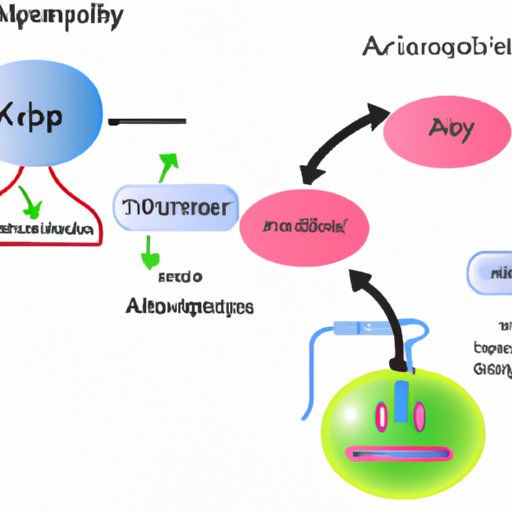Introduction
Cellular respiration is the process by which cells convert food into energy that can be used to power their many activities. This process is essential for all living organisms, as it allows them to produce adenosine triphosphate, or ATP, which serves as the main source of energy for cellular activities. In this article, we will explore the different stages of cellular respiration and determine which stage produces the most ATP.
Breaking Down ATP: Analyzing the Efficiency of Each Stage of Cellular Respiration
ATP, or adenosine triphosphate, is a molecule that carries energy within cells. It is essential for all cellular processes that require an input of energy, including muscle contraction, protein synthesis, and cell division. There are three stages of cellular respiration that contribute to ATP production: glycolysis, Krebs cycle, and electron transport chain.
In glycolysis, glucose is broken down into pyruvate, producing a net yield of 2 ATP molecules. Next, the pyruvate enters the Krebs cycle, where it is further broken down to produce more ATP molecules, along with carbon dioxide and water. This process yields around 2 ATP molecules. Finally, in the electron transport chain, electrons from the Krebs cycle are transported from one molecule to another, producing around 34 ATP molecules through oxidative phosphorylation.
The efficiency of ATP production in each stage depends on various factors, including the availability of oxygen, the concentration of enzymes, and the pH of the environment.
Maximizing Energy Production: Which Stage of Cellular Respiration is the Most Beneficial?
While each stage of cellular respiration contributes to ATP production, some stages are more beneficial than others. The electron transport chain is the most efficient stage of energy production, generating the largest amount of ATP per molecule of glucose consumed. However, the Krebs cycle and glycolysis are also essential stages, as they are the starting points for ATP production.
The optimal stage for ATP production depends on the conditions of the cell. For instance, under low oxygen conditions, glycolysis may be more favorable, whereas in the presence of oxygen, the electron transport chain becomes more efficient for energy production. Additionally, certain cell types may prefer one stage over the other depending on their energy needs.
The Powerhouses of the Cell: Unpacking ATP Production in Cellular Respiration
The electron transport chain is a complex series of proteins and enzymes located in the inner membrane of the mitochondria. The chain is made up of four protein complexes that work together to transport electrons and protons across the membrane, generating a proton gradient. This gradient drives the synthesis of ATP as protons move through ATP synthase, an enzyme that converts ADP to ATP.
The electron transport chain is responsible for producing the majority of ATP molecules in cellular respiration. This stage can produce up to 34 ATP molecules per molecule of glucose, making it the most efficient stage of energy production. However, it is also the most dependent on oxygen as it requires a steady flow of electrons and protons to function properly.
Comparing ATP Yield in Glycolysis, Krebs Cycle, and Electron Transport Chain
The table below shows the ATP yield for each stage of cellular respiration when one molecule of glucose is consumed:
| Stages of Cellular Respiration | ATP Yield |
|---|---|
| Glycolysis | 2 |
| Krebs Cycle | 2 |
| Electron Transport Chain | 34 |
The yield of ATP in each stage of cellular respiration depends on the number of molecules that each stage processes.
Energy Production in Motion: Examining the Processes Behind ATP Synthesis in Cellular Respiration
ATP synthesis is a process that involves the transfer of energy between several molecules. It starts with the breakdown of glucose into pyruvate during glycolysis. The pyruvate then enters the mitochondria, where it is broken down into acetyl-CoA by the Krebs cycle. During this cycle, the energy released from the breakdown of acetyl-CoA is used to power several enzyme-catalyzed reactions that produce ATP molecules.
The final stage of ATP synthesis occurs during the electron transport chain, where a proton gradient is generated by the transfer of electrons. This gradient drives the synthesis of ATP molecules through ATP synthase, allowing cells to produce an abundant supply of energy.
Energy Output from Glucose: Investigating the Most Effective Stage of Cellular Respiration
The amount of ATP produced by each stage of cellular respiration is also dependent on the type of substrate used. When glucose is used as the substrate, glycolysis produces a net yield of 2 ATP molecules, the Krebs cycle produces 2 ATP molecules, and the electron transport chain produces around 34 ATP molecules. This means that the electron transport chain is the most effective stage for producing ATP when glucose is the substrate.
Illuminating the Energy Pathway: Discovering the Most Efficient Stage of ATP Production in Cellular Respiration
Based on the evidence presented in this article, the electron transport chain is the most efficient stage of ATP production in cellular respiration. It produces the most ATP per molecule of glucose consumed, making it the most efficient stage in terms of energy production. However, it is important to note that all three stages of cellular respiration are essential for the generation of ATP, each with their own unique contributions.
Conclusion
Cellular respiration is a complex process that involves three stages, each contributing to the production of ATP. While all three stages are essential for ATP generation, the electron transport chain is the most efficient stage of energy production. Understanding the mechanisms behind ATP production can provide insight into the energy needs of cells and help identify opportunities for improving cellular function.
References
1. Berg, J., Tymoczko, J. L., & Stryer, L. (2002). Biochemistry (5th Ed.). New York: W. H. Freeman.
2. Campbell, N. A., & Reece, J. B. (2005). Biology (7th Ed.). San Francisco: Benjamin Cummings.
3. Lodish, H., Berk, A., Zipursky, S. L., Matsudaira, P., Baltimore, D., & Darnell, J. (2000). Molecular Cell Biology (4th Ed.). New York: W. H. Freeman.
